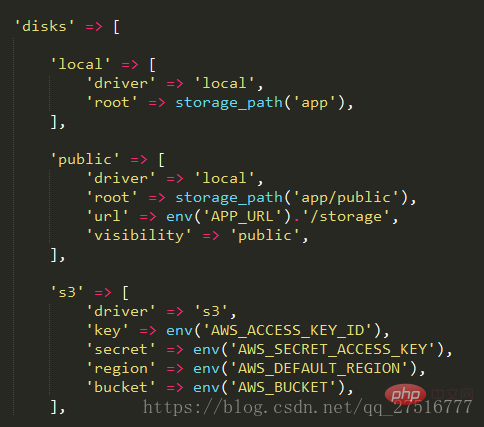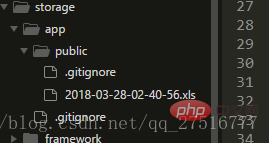The file upload function that comes with laravel system
The following tutorial column of Laravel will introduce to you the file upload function that comes with the laravel system. I hope it will be helpful to friends in need!

As for the function of uploading files, it is difficult to say it. In fact, it is all encapsulated, so it is really not difficult. It’s not difficult to say, various configurations can really give people a headache sometimes. Today, let’s talk about the introduction of laravel’s upload function.
Directly call the command to download a laravel framework from composer, name it blog (this is casual)
Enter the file blog->config->filesystems.php, There is a disk configuration.

Briefly explain the total call of the
- disk configuration item, which will be used later. It can be easily understood by thinking of it as a public calling method.
- local represents one of the small configuration items, because there may be many different storage methods or storage locations in a project. Local, public, and s3 all represent different storage methods.
- driver represents the storage location, like local represents storage in the local project. s3 is a disk location stored in Amazon. There may be many more. At that time, we can continue to create according to these three demo modes.
- Because they are usually stored in the project itself, we will remove s3 below. explain.
- root represents the location where the file is stored. ‘app/public’ means that the files are stored under blog->storage->app->public. ''app/public'' can be changed at will.
- Normally just like the two local configurations.
After configuring, it’s time to get to the code block. Code blocks are quite simple.
- Create a route, just define the route yourself (no need to explain this)
- Write the method corresponding to the route, and start writing code in the method.
Front-end code
<p class="container">
<p class="panel-heading">上传文件</p>
<form class="form-horizontal" method="POST" action="" enctype="multipart/form-data">
{{ csrf_field() }}
<label for="file">选择文件</label>
<input id="file" type="file" class="form-control" name="source" required>
<button type="submit" class="btn btn-primary">确定</button>
</form>
</p>The red part of the code must be added. If not, the following Code verification in php statements cannot be achieved
Back-end code
3
public function upload(Request $request){
if ($request->isMethod('POST')) { //判断是否是POST上传,应该不会有人用get吧,恩,不会的
//在源生的php代码中是使用$_FILE来查看上传文件的属性
//但是在laravel里面有更好的封装好的方法,就是下面这个
//显示的属性更多
$fileCharater = $request->file('source');
if ($fileCharater->isValid()) { //括号里面的是必须加的哦
//如果括号里面的不加上的话,下面的方法也无法调用的
//获取文件的扩展名
$ext = $fileCharater->getClientOriginalExtension();
//获取文件的绝对路径
$path = $fileCharater->getRealPath();
//定义文件名
$filename = date('Y-m-d-h-i-s').'.'.$ext;
//存储文件。disk里面的public。总的来说,就是调用disk模块里的public配置
Storage::disk('public')->put($filename, file_get_contents($path));
}
}
return view('upload');
}The editor is I was typing while I was working on it, for fear that I would make a mistake and make you laugh. Finally, the file was uploaded successfully.

The above is the detailed content of The file upload function that comes with laravel system. For more information, please follow other related articles on the PHP Chinese website!

Hot AI Tools

Undresser.AI Undress
AI-powered app for creating realistic nude photos

AI Clothes Remover
Online AI tool for removing clothes from photos.

Undress AI Tool
Undress images for free

Clothoff.io
AI clothes remover

Video Face Swap
Swap faces in any video effortlessly with our completely free AI face swap tool!

Hot Article

Hot Tools

Notepad++7.3.1
Easy-to-use and free code editor

SublimeText3 Chinese version
Chinese version, very easy to use

Zend Studio 13.0.1
Powerful PHP integrated development environment

Dreamweaver CS6
Visual web development tools

SublimeText3 Mac version
God-level code editing software (SublimeText3)

Hot Topics
 How to get the return code when email sending fails in Laravel?
Apr 01, 2025 pm 02:45 PM
How to get the return code when email sending fails in Laravel?
Apr 01, 2025 pm 02:45 PM
Method for obtaining the return code when Laravel email sending fails. When using Laravel to develop applications, you often encounter situations where you need to send verification codes. And in reality...
 Laravel Eloquent ORM in Bangla partial model search)
Apr 08, 2025 pm 02:06 PM
Laravel Eloquent ORM in Bangla partial model search)
Apr 08, 2025 pm 02:06 PM
LaravelEloquent Model Retrieval: Easily obtaining database data EloquentORM provides a concise and easy-to-understand way to operate the database. This article will introduce various Eloquent model search techniques in detail to help you obtain data from the database efficiently. 1. Get all records. Use the all() method to get all records in the database table: useApp\Models\Post;$posts=Post::all(); This will return a collection. You can access data using foreach loop or other collection methods: foreach($postsas$post){echo$post->
 Laravel Introduction Example
Apr 18, 2025 pm 12:45 PM
Laravel Introduction Example
Apr 18, 2025 pm 12:45 PM
Laravel is a PHP framework for easy building of web applications. It provides a range of powerful features including: Installation: Install the Laravel CLI globally with Composer and create applications in the project directory. Routing: Define the relationship between the URL and the handler in routes/web.php. View: Create a view in resources/views to render the application's interface. Database Integration: Provides out-of-the-box integration with databases such as MySQL and uses migration to create and modify tables. Model and Controller: The model represents the database entity and the controller processes HTTP requests.
 Laravel's geospatial: Optimization of interactive maps and large amounts of data
Apr 08, 2025 pm 12:24 PM
Laravel's geospatial: Optimization of interactive maps and large amounts of data
Apr 08, 2025 pm 12:24 PM
Efficiently process 7 million records and create interactive maps with geospatial technology. This article explores how to efficiently process over 7 million records using Laravel and MySQL and convert them into interactive map visualizations. Initial challenge project requirements: Extract valuable insights using 7 million records in MySQL database. Many people first consider programming languages, but ignore the database itself: Can it meet the needs? Is data migration or structural adjustment required? Can MySQL withstand such a large data load? Preliminary analysis: Key filters and properties need to be identified. After analysis, it was found that only a few attributes were related to the solution. We verified the feasibility of the filter and set some restrictions to optimize the search. Map search based on city
 Laravel user login function
Apr 18, 2025 pm 12:48 PM
Laravel user login function
Apr 18, 2025 pm 12:48 PM
Laravel provides a comprehensive Auth framework for implementing user login functions, including: Defining user models (Eloquent model), creating login forms (Blade template engine), writing login controllers (inheriting Auth\LoginController), verifying login requests (Auth::attempt) Redirecting after login is successful (redirect) considering security factors: hash passwords, anti-CSRF protection, rate limiting and security headers. In addition, the Auth framework also provides functions such as resetting passwords, registering and verifying emails. For details, please refer to the Laravel documentation: https://laravel.com/doc
 Laravel and the Backend: Powering Web Application Logic
Apr 11, 2025 am 11:29 AM
Laravel and the Backend: Powering Web Application Logic
Apr 11, 2025 am 11:29 AM
How does Laravel play a role in backend logic? It simplifies and enhances backend development through routing systems, EloquentORM, authentication and authorization, event and listeners, and performance optimization. 1. The routing system allows the definition of URL structure and request processing logic. 2.EloquentORM simplifies database interaction. 3. The authentication and authorization system is convenient for user management. 4. The event and listener implement loosely coupled code structure. 5. Performance optimization improves application efficiency through caching and queueing.
 Solve caching issues in Craft CMS: Using wiejeben/craft-laravel-mix plug-in
Apr 18, 2025 am 09:24 AM
Solve caching issues in Craft CMS: Using wiejeben/craft-laravel-mix plug-in
Apr 18, 2025 am 09:24 AM
When developing websites using CraftCMS, you often encounter resource file caching problems, especially when you frequently update CSS and JavaScript files, old versions of files may still be cached by the browser, causing users to not see the latest changes in time. This problem not only affects the user experience, but also increases the difficulty of development and debugging. Recently, I encountered similar troubles in my project, and after some exploration, I found the plugin wiejeben/craft-laravel-mix, which perfectly solved my caching problem.
 Laravel framework installation method
Apr 18, 2025 pm 12:54 PM
Laravel framework installation method
Apr 18, 2025 pm 12:54 PM
Article summary: This article provides detailed step-by-step instructions to guide readers on how to easily install the Laravel framework. Laravel is a powerful PHP framework that speeds up the development process of web applications. This tutorial covers the installation process from system requirements to configuring databases and setting up routing. By following these steps, readers can quickly and efficiently lay a solid foundation for their Laravel project.






